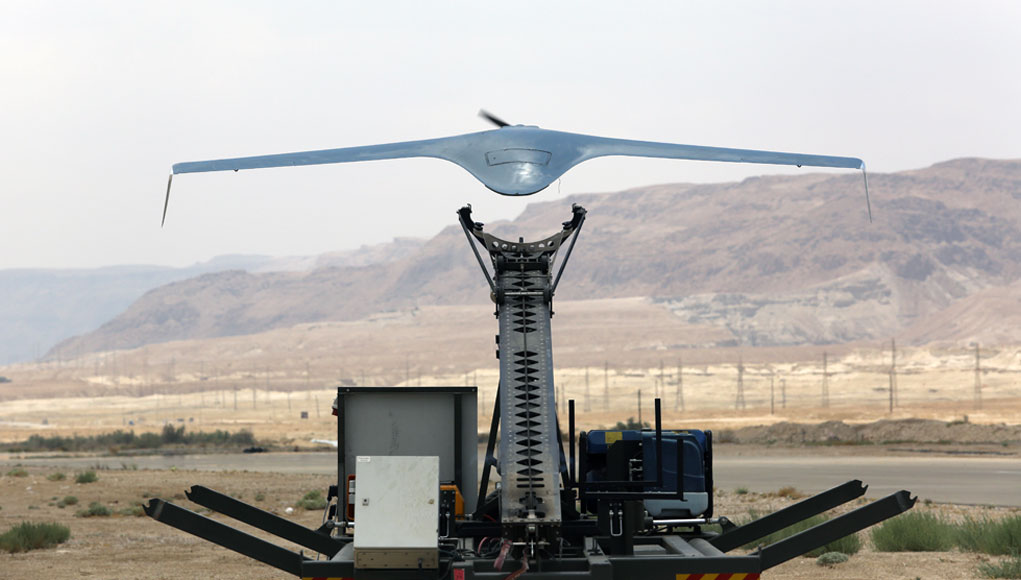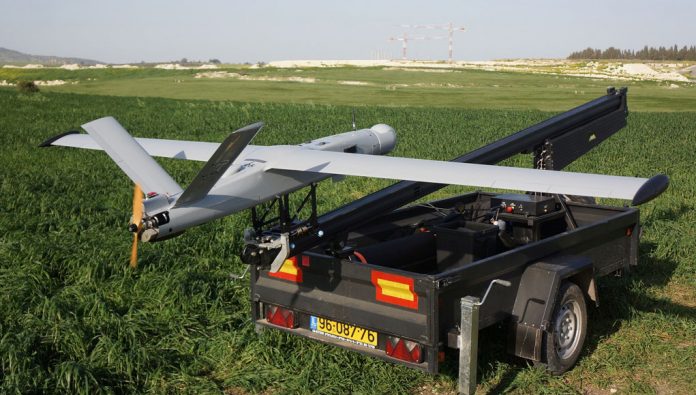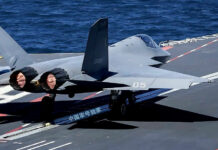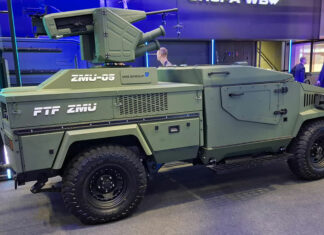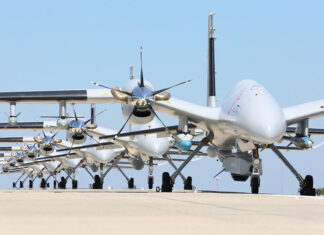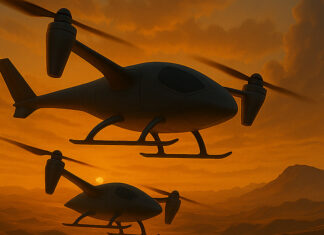Four unmanned systems developers from Israel are introducing new versions of Small Tactical Unmanned Aerial Systems (STUAS) at Eurosatory, addressing the growing interest in tactical UAS among military forces worldwide.
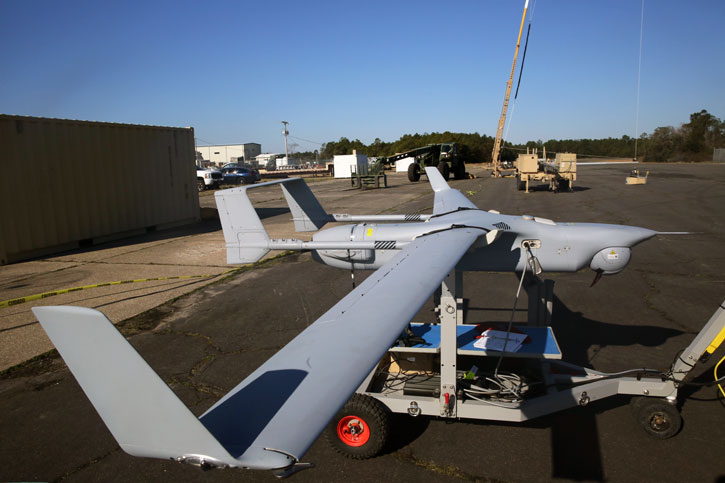
The Skyhook, a unique retrieval system used by the Blackjack enables recovery of RQ-21A drones anywhere on land and at sea, without dependence on a landing strip. The drone can stay airborne for 16 hours at a service ceiling of 19,500 ft.
Despite its operational versatility, the RQ-21A is quite limited in its mission configurations, as it is dependent on specific payloads to carry out its tasks.
Watch the playlist of all four platforms above.
Smaller and lighter tactical drones that have evolved in Israel in recent years support such capabilities. Most systems weigh about half the weight of the Integrator; the latest versions are capable of fulfilling most of the missions carried by the new US drone.
The Orbiter 3, an electrically powered UAV developed by Israel’s Aeronautics Systems, is available in two variants that pioneered the STUAS category – a platform that can deploy and operate at the battalion and brigade level, perform missions at altitudes of 5,000 – 10,000 ft. for several hours and carry payloads weighing up to 10 pounds.
The Orbiter 3, an electrically powered UAV developed by Israel’s Aeronautics Systems, is available in two variants that have pioneered the STUAS category – a platform that can deploy and operate at the battalion and brigade level, perform missions at altitudes of 5,000 – 10,000 ft. for several hours and carry payloads weighing up to 10 pounds. Electrical propulsion provides the drone acoustic stealth capability, particularly at night, when the familiar signsture of piston-engines is clearly heard.
Israel showcases not less than four new or upgraded drones designed for the STUAS category. Four companies – IAI, Elbit Systems, Aeronautics, and BlueBird Aerosystems, display such platforms. All have roughly the same dimensions (about four-meter wingspan), weighing 30-40 kg.
All Four systems presented by the Israeli companies are launched from a catapult and retrieved by parachute and airbag cushion.
All reflect recent redesigns aimed to better position these platforms to address new requirements that evolve from the intensive hybrid warfare events that are shaping modern military operations.
The similar dimensions derive from the sensors these drones are designed to carry – stabilized, multi-sensor EO/IR payloads weighing 3-5 kg, electronic monitoring packages, and RF jammers, weighing up to one kilogram each, are all designed to support the potential missions of such platforms.

Aeronautics Systems had fielded its version of Mini-Tactical drone – the Orbiter 3. This drone has evolved through the development process, and is currently in the Orbiter 3B version, an electrically powered flying wing, with a gross takeoff weight of 30 kg, carrying payloads up to 5.5 kg weight. The remaining payload is reserved for batteries, providing an endurance of 7 hours. To extend its mission Aeronautics developed the Orbiter 3LE and Orbiter 4, powered by internal combustion engines. Orbiter 4, currently in development, will have a GTOW of 50 kg, and operating ceiling of 18,000, enabling line-of-sight control beyond 250 km and mission endurance beyond 24 hours.
IAI’s BirdEye 650 also began its way as an electrically-propelled platform. Shifting to internal combustion gasoline engine, IAI squeezed more endurance form its newly designed BirdEye 650D, a flying wing shaped STUAS that weighs 30 kg on takeoff.
The BirdEye 650D, designed for military and paramilitary intelligence, surveillance and reconnaissance (ISR) can conduct autonomous missions including point takeoff, point recovery, at an altitude of 15,000 ft.; the drone can operate at ranges of up to 150 km and endurance of more than 15 hours.
Designed to support mobile land forces the ‘650D operates from a dedicated vehicle that packs all the support systems required for operation, including multiple packed drones, launch rail, communications link and operator controls. IAI designed it as a generic platform that can quickly reconfigure with different payloads of up to 5.5 kg weight, including electro-optical gimbaled payloads covering different spectral bands, and Passive RWR/RWL electronic countermeasures (ECM). Bird Eye 650D can conduct precision electronic warfare by deploying communications jamming (COMJAM) close to the enemy, thus minimizing interference with friendly forces.
The latest Israeli entry in the Small, Tactical UAS category is the ThunderB from BlueBird Aerosystems – the most recent upgrade implemented with this drone made the thunder the first Israeli STUAS to achieve the goal of 24-hour operation with such small platform. The small drone has already passed its first combat test in April, during hostilities that erupted between Armenia and Azerbaijan. One of the ThunderB drones operated by the Azeri side crashed and fell into Armenian hands, thus revealing its use in the Caucasus.
“We have developed the ThunderB in response to the need for a field-launched, long-range, long-endurance UAS, capable of complex missions that, until now, required the use of significantly larger platforms, logistical footprint, and higher life-cycle-cost.” Said Mr. Ronen Nadir, Bluebird’s CEO. The ThunderB, with its automatic field launch by a small pneumatic launcher and automatic field recovery utilizing a parachute and an airbag, can be deployed and operated from a small vehicle or trailer, eliminating the need for costly infrastructure such as runways, hangars, etc.
The ThunderB’s extended mission range to 150km and endurance of 24h to enable around-the-clock support for tactical ground forces. Such functions can provide forward observer, pre-mission Intelligence collection, persistent surveillance, and Battle Damage Assessment (BDA).
ThunderB is a tactical-sized UAS, weighing 28kg, with a wingspan of 4m, undetectable to the naked eye even when cruising at altitudes as low as 3000 ft. The system’s unprecedented reliability and endurance are based on an advanced computerized electronic fuel-injected (EFI) engine, coupled with multiple system redundancies throughout the UAS.
